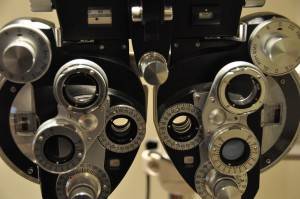As technology is advancing, so is the use of technology becoming an integral part of care in the optometry world. At Whitby Vision Care, we strive to keep up to date with new and advanced technology that improves patient care, and helps aid in the diagnosis of eye diseases earlier. Preventative medicine is the key.
Digital Retinal Imaging

We use cutting-edge digital imaging technology to assess your eyes. Many eye diseases, if detected at an early stage, can be treated successfully without total loss of vision. Your retinal Images will be stored electronically. This gives the eye doctor a permanent record of the condition and state of your retina.
This is very important in assisting your Optometrist to detect and measure any changes to your retina each time you get your eyes examined, as many eye conditions, such as glaucoma, diabetic retinopathy and macular degeneration are diagnosed by detecting changes over time.
The advantages of digital imaging include:
- Quick, safe, non-invasive and painless
- Provides detailed images of your retina and sub-surface of your eyes
- Provides instant, direct imaging of the form and structure of eye tissue
- Image resolution is extremely high quality
- Uses eye-safe near-infra-red light
- No patient prep required
Digital Retinal Imaging allows your eye doctor to evaluate the health of the back of your eye, the retina. It is critical to confirm the health of the retina, optic nerve and other retinal structures. The digital camera snaps a high-resolution digital picture of your retina. This picture clearly shows the health of your eyes and is used as a baseline to track any changes in your eyes in future eye examinations.
Optical Coherence Tomography (OCT)
An Optical Coherence Tomography scan (commonly referred to as an OCT scan) is the latest advancement in imaging technology. Similar to ultrasound, this diagnostic technique employs light rather than sound waves to achieve higher resolution pictures of the structural layers of the back of the eye.
A scanning laser used to analyze the layers of the retina and optic nerve for any signs of eye disease, similar to an CT scan of the eye. It works using light without radiation, and is essential for early diagnosis of glaucoma, macular degeneration, diabetic retinal disease and other ocular diseases.
With an OCT scan, doctors are provided with color-coded, cross-sectional images of the retina. These detailed images are revolutionizing early detection and treatment of eye conditions such as wet and dry age-related macular degeneration, glaucoma, retinal detachment and diabetic retinopathy.
An OCT scan is a noninvasive, painless test. It is performed in about 10 minutes right in our office.
Visual Field Testing
A visual field test measures the range of your peripheral or “side” vision to assess whether you have any blind spots (scotomas), peripheral vision loss or visual field abnormalities. It is a straightforward and painless test that does not involve eye drops but does involve the patient’s ability to understand and follow instructions.
An initial visual field screening can be carried out by the optometrist by asking you to keep your gaze fixed on a central object, covering one eye and having you describe what you see at the periphery of your field of view. For a more comprehensive assessment, special equipment might be used to test your visual field. In one such test, you place your chin on a chin rest and look ahead. Lights are flashed on, and you have to press a button whenever you see the light. The lights are bright or dim at different stages of the test. Some of the flashes are purely to check you are concentrating. Each eye is tested separately and the entire test takes 15-45 minutes. These machines can create a computerized map out your visual field to identify if and where you have any deficiencies.
Visual field testing is often a requirement for certain applications for jobs or to maintain certain licenses. Discuss with our doctors if this is required for your occupation.
Macular Degeneration Genetic Testing
Age-related macular degeneration is a common disease that can affect central vision usually in people 55 and older. Since people with a close relative who has macular degermation have an increased risk of getting the disease, genetic studies have been done to determine which genes contribute to the increased risk.
Our office now has available two types of genetic tests: Vita Risk genetic test and Macula risk genetic test. Vita Risk testing identifies patients who have an increased risk of progression to wet macular degeneration after chronic exposure to zinc, allowing patients to avoid supplements that may increase their risk of vision loss. Macula Risk genetic testing helps doctors identify those at high risk for macular degeneration progression. These patients require increased monitoring and often and early referral to a retinal specialist to preserve their sight.
Speak to one of our optometrist at your next appointment about the option of genetic AMD testing and if its suitable to you.



